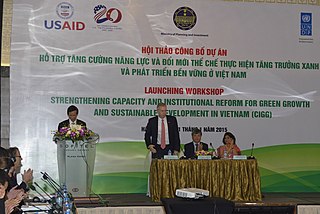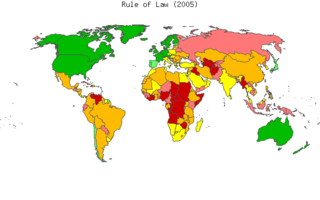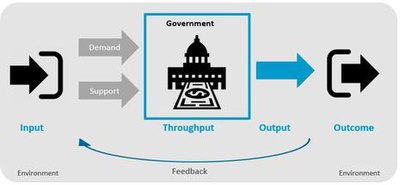Quality of life (QOL) is defined by the World Health Organization as "an individual's perception of their position in life in the context of the culture and value systems in which they live and in relation to their goals, expectations, standards and concerns".

International development or global development is a broad concept denoting the idea that societies and countries have differing levels of economic or human development on an international scale. It is the basis for international classifications such as developed country, developing country and least developed country, and for a field of practice and research that in various ways engages with international development processes. There are, however, many schools of thought and conventions regarding which are the exact features constituting the "development" of a country.
Governance is the process of making and enforcing decisions within an organization or society. It is the process of interactions through the laws, social norms, power or language as structured in communication of an organized society over a social system. It is done by the government of a state, by a market, or by a network. It is the process of choosing the right course among the actors involved in a collective problem that leads to the creation, reinforcement, or reproduction of acceptable conduct and social order". In lay terms, it could be described as the processes that exist in and between formal institutions.

Gross National Happiness, sometimes called Gross Domestic Happiness (GDH), is a philosophy that guides the government of Bhutan. It includes an index which is used to measure the collective happiness and well-being of a population. Gross National Happiness Index is instituted as the goal of the government of Bhutan in the Constitution of Bhutan, enacted on 18 July 2008.
New Public Management (NPM) is an approach to running public service organizations that is used in government and public service institutions and agencies, at both sub-national and national levels. The term was first introduced by academics in the UK and Australia to describe approaches that were developed during the 1980s as part of an effort to make the public service more "businesslike" and to improve its efficiency by using private sector management models.

An air quality index (AQI) is an indicator developed by government agencies to communicate to the public how polluted the air currently is or how polluted it is forecast to become. As air pollution levels rise, so does the AQI, along with the associated public health risk. Children, the elderly and individuals with respiratory or cardiovascular problems are typically the first groups affected by poor air quality. When the AQI is high, governmental bodies generally encourage people to reduce physical activity outdoors, or even avoid going out altogether. When wildfires result in a high AQI, the use of masks such as N95 respirators outdoors and air purifiers incorporating HEPA filters indoors are also encouraged.

Capacity building is the improvement in an individual's or organization's facility "to produce, perform or deploy". The terms capacity building and capacity development have often been used interchangeably, although a publication by OECD-DAC stated in 2006 that capacity development was the preferable term. Since the 1950s, international organizations, governments, non-governmental organizations (NGOs) and communities use the concept of capacity building as part of "social and economic development" in national and subnational plans. The United Nations Development Programme defines itself by "capacity development" in the sense of "'how UNDP works" to fulfill its mission. The UN system applies it in almost every sector, including several of the Sustainable Development Goals to be achieved by 2030. For example, the Sustainable Development Goal 17 advocates for enhanced international support for capacity building in developing countries to support national plans to implement the 2030 Agenda.

Based on a long-standing research program of the World Bank, the Worldwide Governance Indicators capture six key dimensions of governance between 1996 and present. They measure the quality of governance in over 200 countries, based on close to 40 data sources produced by over 30 organizations worldwide and are updated annually since 2002.

The Global Financial Centres Index (GFCI) is a ranking of the competitiveness of financial centres based on over 29,000 financial centre assessments from an online questionnaire together with over 100 indices from organisations such as the World Bank, the Organisation for Economic Co-operation and Development (OECD), and the Economist Intelligence Unit. The first index was published in March 2007. It has been jointly published twice per year by Z/Yen Group in London and the China Development Institute in Shenzhen since 2015, and is widely quoted as a top source for ranking financial centres.
Daniel Kaufmann is the president emeritus of the Natural Resource Governance Institute (NRGI), which resulted from the merger of the Revenue Watch Institute – Natural Resource Charter. He is also a nonresident senior fellow at the Brookings Institution, where he was previously a senior fellow, and until July 2019 served in the international board of the Extractive Industries Transparency Initiative and in a number of advisory boards on governance, anti-corruption and natural resources and has also been in high-level expert commissions such as at the Organisation for Economic Co-operation and Development, the Inter-American Development Bank and the Mo Ibrahim Foundation. Prior to that, he was a director at the World Bank Institute, leading work on governance and anti-corruption. He was also a senior manager and lead economist at the World Bank, writing and working on many countries around the world, and was a visiting scholar at Harvard University. He has also served in other boards and councils in the past, including at the World Economic Forum.
Sustainability metrics and indices are measures of sustainability, and attempt to quantify beyond the generic concept. Though there are disagreements among those from different disciplines, these disciplines and international organizations have each offered measures or indicators of how to measure the concept.
The Sustainable Governance Indicators (SGI), first published in spring 2009 and updated in 2011, analyze and compare the need for reform in Organisation for Economic Co-operation and Development (OECD) member countries, as well as each country's ability to respond to current social and political challenges. The project is designed to create a comprehensive data pool on government-related activities in the countries considered the world's most developed free-market democracies. In addition, it uses international comparisons to provide evidence-based input for reform-related public discourse taking place in these countries. The SGI are updated every two or three years.
Canada ranks among the highest in international measurements of government transparency, civil liberties, quality of life, economic freedom, education levels, gender equality, public services, public security and environmental sustainability. It ranks among the lowest of the most developed countries for housing affordability, healthcare services and foreign direct investment.
The Worldwide Governance Indicators (WGI) is a project that reports both aggregate and individual governance indicators for over 200 countries and territories covering the period from 1996 to 2021. It considers six dimensions of governance:
The OECD Better Life Index, created in May 2011 by the Organisation for Economic Co-operation and Development, is an initiative pioneering the development of economic indicators which better capture multiple dimensions of economic and social progress.
Wikiprogress is a defunct online platform for sharing information on the measurement of social, economic and environmental progress. It is thought to facilitate sharing on ideas, initiatives and knowledge on "measuring the progress of societies". Like Wikipedia, it was open to all members and communities for contribution – anyone interested in "progress" could register.
Although for many decades, it was customary to focus on GDP and other measures of national income, there has been growing interest in developing broad measures of economic well-being. National and international approaches include the Beyond GDP programme developed by the European Union, the Better Lives Compendium of Indicators developed by the OECD, as well as many alternative metrics of wellbeing or happiness. One of the earliest attempts to develop such an index at national level was Bhutan's Gross National Happiness Index and there are a now a number of similar projects ongoing around the world, including a project to develop for the UK an assessment of national well-being, commissioned by the Prime Minister David Cameron and led by the Office for National Statistics.
Tobin Im is a scholar of public administration and a professor at the Graduate School of Public Administration at Seoul National University. He specializes in public management, organization theory, and comparative administration.

The Bertelsmann Transformation Index (BTI) is a measure of the development status and governance of political and economic transformation processes in developing and transition countries around the world. The BTI has been published biennially by the Bertelsmann Stiftung since 2005, most recently in 2022 on 137 countries. The index measures and compares the quality of government action in a ranking list based on self-recorded data and analyzes successes and setbacks on the path to constitutional democracy and a market economy accompanied by sociopolitical support. For this purpose, the "Status Index" is calculated on the general level of development with regard to democratic and market-economy characteristics and the "Management Index" on the political management of decision-makers.







